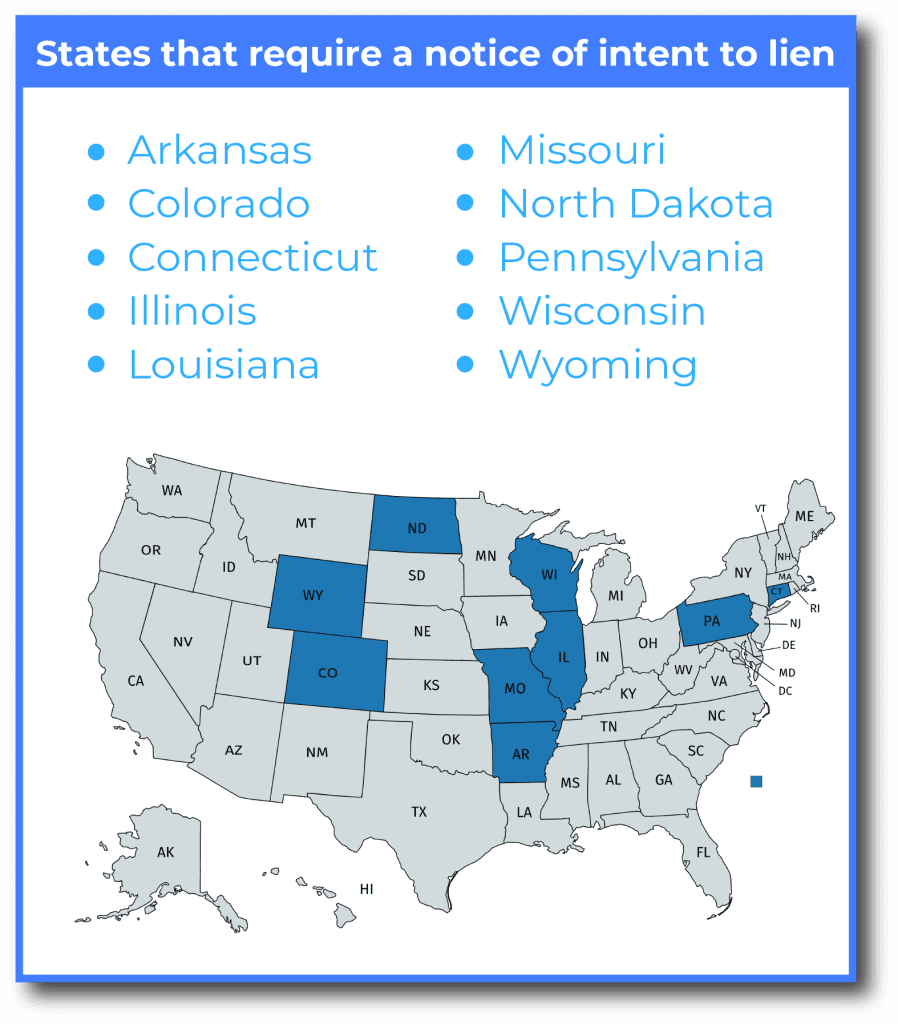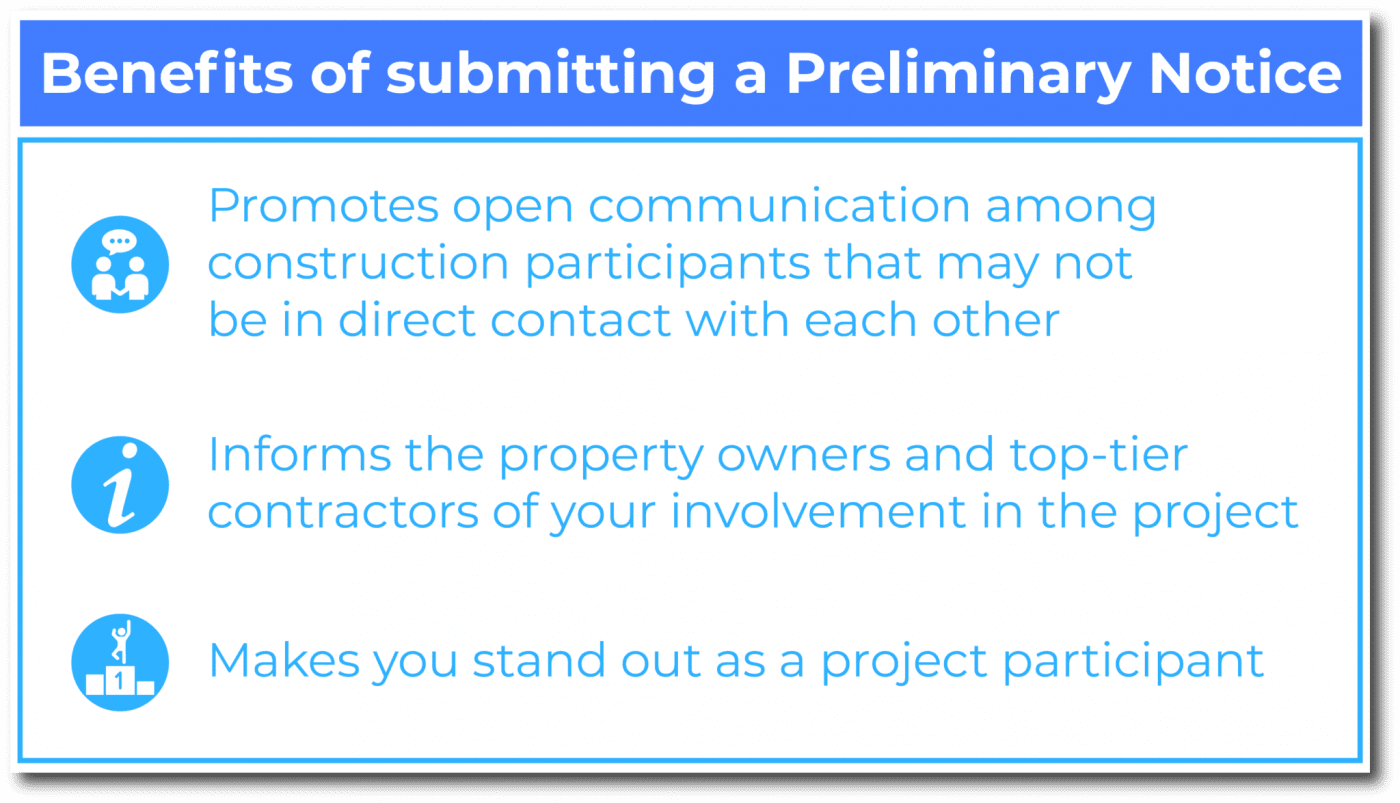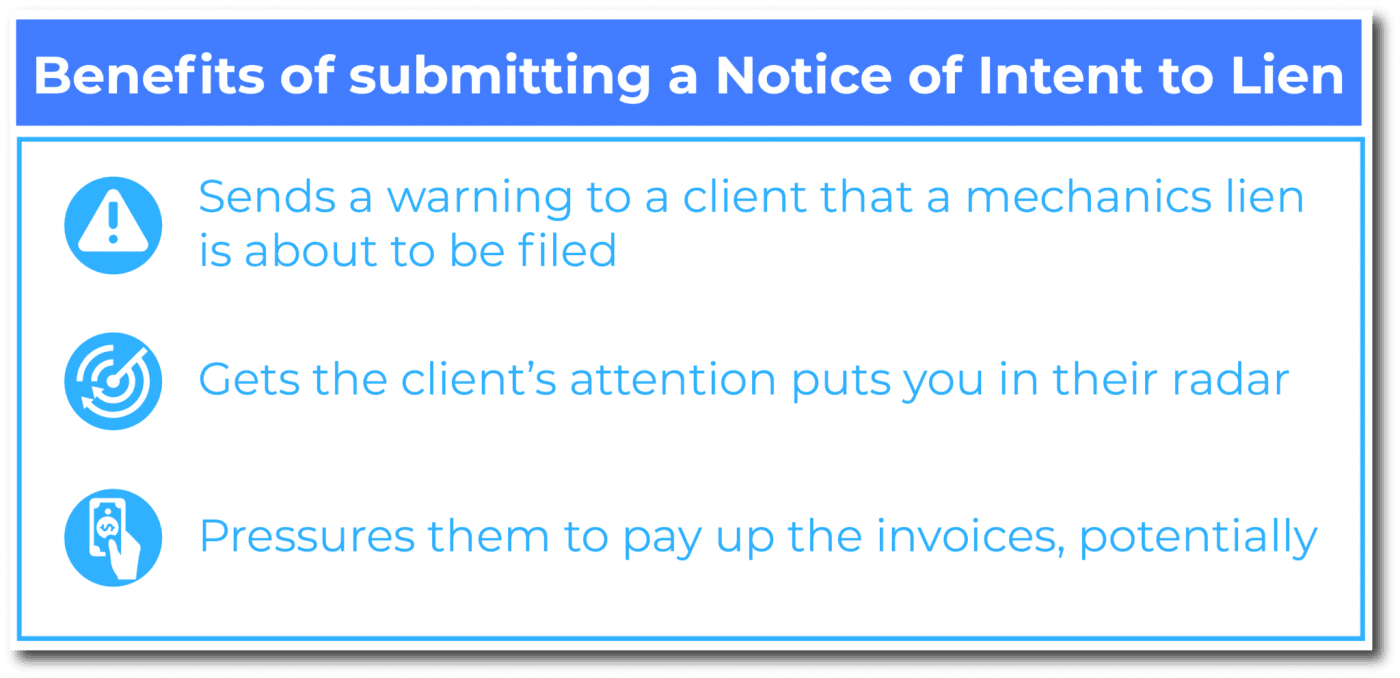

Filing a mechanics lien is one of the most effective steps a contractor can take to settle unresolved payment disputes with their clients. But there are two pre-lien notices that can be potentially as effective and are arguably just as important as the mechanics lien.
The Preliminary Notice and the Notice of Intent to Lien are essential pre-lien documents that could make or break contractors’ chance of being duly compensated for their services. It is extremely important for contractors, subcontractors, and other stakeholders in a construction project to familiarize themselves with the processes and requirements behind these pre-lien documents.
Being well-informed about efficient pre-lien instructions and steps could greatly help construction professionals secure payment from non-paying clients, who are unfortunately common in the construction industry.
Both the Preliminary Notice and the Notice of Intent to Lien are submitted prior to filing an actual mechanics lien. However, they are not the same documents so one could not be filed in place of the other.
The Preliminary Notice — also known as construction notice, notice to owner (NTO), or pre-lien notice — is a legal document that informs the property owner of their obligation to pay the contractors, subcontractors, and material suppliers for the services that these stakeholders will be providing.
Typically, a preliminary notice contains basic information regarding a project, including the name of the property owner as well as the description of the property location. It also usually includes a statement proclaiming that you are aware of your lien rights and are willing to exercise them if payment issues arise.
In most states, submitting the Preliminary Notice is key to protecting a project participant’s right to file a mechanics lien. Serving a preliminary notice is a mandatory step to secure your lien rights; failing to serve this notice may result in the invalidation of your mechanics lien.
A preliminary notice can come in many forms, including a contractor sworn statement, notice of furnishing, and notice to owner.
Sworn statements or affidavits are typically required from general contractors. They usually contain a list of subcontractors and materialmen working under them, and the amounts that are due to these parties. States like Michigan and Illinois require general contractors to serve a sworn statement for their mechanics lien to be enforceable.
A notice of furnishing is a general preliminary notice that informs a property owner that you have begun furnishing labor or materials to a project. Four states officially call their preliminary notice a Notice of Furnishing: South Dakota, Ohio, South Carolina, and Michigan.
A notice to owner is another type of preliminary notice. States like Oregon, Florida, Colorado, and Washington require a Notice to Owner from their construction participants. Keep in mind, however, that the specified requirements surround the information that must be included in the notice and the deadlines by which it must be sent still vary per state.
The Notice of Intent to Lien is another legal document that announces the project participant’s intention of filing a mechanics lien. In some instances, serving the Notice of Intent to Lien is enough to get a property owner or a contractor to pay up.
Generally, a Notice of Intent to Lien is served when a payment issue has already arisen and you want to notify a property owner about your intentions to attach a lien against their property. This notice acts as an ultimatum for the property owner to settle outstanding debts before a mechanics lien is officially recorded.
Some states require a Notice of Intent to Lien to be served to higher tier parties before a mechanics lien can be officially filed. It goes without saying that in these states, failing to serve a Notice of Intent to Lien automatically revokes your lien rights.
There are states, however, in which serving a Notice of Intent to Lien is not mandatory. This implies that you may go straight to the local county recorder’s office and file your mechanics lien without informing the property owner. Keep in mind, though, that setting an ultimatum to the property owner before filing a mechanics lien can be effective in encouraging them to produce payment.
Reminders:Neither the Preliminary Notice nor the Notice of Intent to Lien is equivalent to an actual mechanics lien. If you have submitted both notices and still remain unpaid, you will have to file a mechanics lien to exercise your lien rights.
The Preliminary Notice is submitted before or soon after a project has started, while the Notice of Intent to Lien is submitted after a payment issue has already arisen (i.e. the owner has failed to produce payment after the invoice deadline).
Contractors, subcontractors, and material suppliers are the ones who typically serve the Preliminary Notice. For private contracts, all or any of them are allowed to send a preliminary notice to the party in charge, typically the property owner, the general contractor, or the construction lender.
For public contracts, subcontractors and material suppliers that are second-tier and below may submit the form. Projects that are financed through a lender require only the general contractor to send the document.
The Notice of Intent to Lien is filed by the party who wants to secure payment from a client who has failed to pay up on time. So if you’re a contractor, a subcontractor, a sub-subcontractor, or a material supplier, you can serve a Notice of Intent to Lien to remind your client that they still owe you money.
This question implies that neither of the two documents are required in all states. However, in states in which you are obligated to file these notices, you must absolutely make sure that you serve them properly and on time
The Preliminary Notice is required in nearly every state, from Texas to Oregon to Ohio. This implies that failure to submit a preliminary notice in almost all of the states will effectively void the contractors’ and subcontractors’ rights to file a mechanics lien and eventually pursue delinquent clients.
Direct or prime contractors are required to submit a preliminary notice in virtually all states except Mississippi and Texas. In these two states, the notice is only obligatory upon request or upon submission of other non-lien related documents.
In states like Alabama, Illinois, Indiana, Iowa, and Oklahoma, there are certain amount requirements in the contracts before a preliminary notice becomes absolutely necessary.
Keep in mind, however, that it is still highly advisable for contractors to send a preliminary notice even if it is not a requirement. Sending a Preliminary Notice to the property owner or the prime contractor, especially if you are not in direct contact with either party, is a good way to inform them about your participation in the project.

The following states require contractors, subcontractors, and suppliers to write a notice of intent to lien:
Filing a notice of intent to lien in Florida and in other remaining states is optional. However, it is still strongly recommend for contractors living in these states to still file a notice of intent to lien, even if they are not obligated to do so.
While a Notice of Intent to Lien is not the same as a mechanics lien, filing a Notice of Intent to Lien could work as a warning for the property owners and could encourage them to release payment.
It is not enough that you file these pre-lien notices — you must also file them within a period of time, especially when you are working on a project in which these notices are a requirement.
The party that is in charge of sending the Preliminary Notice must ensure that they submit this document in the earliest stage in the project, ideally right when the project begins or even before it commences. Nearly all states require a preliminary notice so prioritizing the submission of this notice can be considered good business practice.
Securing lien rights should be the very first step in a contractor’s mind when entering a project.
This preliminary notice must be submitted before or shortly after the contractor’s work has officially begun. It is common practice to send the notice usually within the first 10 to 30 days of a project.
In the state of California, preliminary notices are also known as the 20-day preliminary notice. And in all states like California, preliminary notice forms are available for free to be used as templates.
Unlike the preliminary notice, the notice of intent to lien is sent right after a payment deadline has passed and the client has failed to fulfill their end of the deal. Keep this in mind, as most construction professionals still get confused between when to file the Notice of Intent to Lien versus the Preliminary Notice.
The following states that require a Notice of Intent to Lien have specific timelines as to when you could file a Notice of Intent to Lien for the document to be considered valid:
· Arkansas – at least 10 days before filing the mechanics lien
· Colorado – at least 10 days before filing the mechanics lien
· Connecticut – within 90 days after the last day of rendering service to the project
· Illinois – within 90 days after the last day of rendering service to the project
· Missouri – at least 10 days before filing the mechanics lien
· North Dakota – at least 10 days prior to filing the lien
· Pennsylvania – at least 10 days prior to filing the lien
· Wisconsin – at least 30 days prior to filing the lien
· Wyoming – at least 20 days prior to filing the lien
The short answer is yes. Even if you are working in a state that does not require either of the two pre-lien notices, there are still benefits to serving them that could help you in protecting your lien rights and securing your payment.

Sending a Preliminary Notice connects the communication lines between the property owners, the contractors, and other participants in the project. The preliminary notice lays out and clarifies the participant’s roles and expectations, and it reinforces the contractual obligations of the owner and the contractor.
The Preliminary Notice may initially seem awkward because the client could take it as a threat. But since this document is a legal document, you may simply present it as part of their professional operating procedures.
Filing the Preliminary Notice also allows the subcontractors, sub-subcontractors, or material suppliers to effectively stand out to their clients.
Some projects can be very large in scope with multiple contractors and subcontractors involved. The ones who sent a preliminary notice may be prioritized when billing time comes just because they submitted an official declaration of their proactive approach to securing payment.
The Preliminary Notice may not only speed up the payment process, but it may also save you from having to file an actual mechanics lien. If the preliminary notice catches the client’s attention and consequently encourages them to pay you on time, then this notice is also an effective way to save time and effort in researching and doing the paperwork for the actual mechanics lien.

The notice of intent to lien is a relatively less dramatic way of declaring an ultimatum to your clients and forcing them to finally settle their unpaid bills.
Compared to filing a mechanics lien, writing the notice of intent to lien requires way less work and does not involve investigating property records and debts. There are also no service and court fees that must be paid so writing a letter of intent to lien is also definitely less expensive.
Writing a notice of intent is also essentially risk-free. The contractor does not lose anything by expressing their intention to file a mechanics lien against a client who has failed to pay the invoices after the deadline has passed.

Since the Notice of Intent has been proven to be an effective way in pressuring the clients to iron out their payment issues, the contactor may be able to gain everything, including the long overdue payment, even without resorting to complicated mechanics lien measures.
Just like the Preliminary Notice, the Notice of Intent to Lien can also be an effective way in bringing the contractor’s company to the attention of the client. This should be a no-brainer, but sometimes the client may be dealing with multiple contractors and suppliers and the best way to grab their attention is to express the intention of filing a lien.
The construction industry is already known for payment delays and abuses; keeping the communication channels flowing between contractors and clients may be a good way to address this.
Filing the necessary pre-lien notices does not guarantee that your lien rights are protected. There are things you must keep in mind in order to ensure that you retain your right to file a mechanics lien.
Be wary not to miss the deadline for filing the Preliminary Notice. Some states forfeit your lien rights the moment you fail to file a Preliminary Notices. States like California allows claimants to still send a Preliminary Notice after the 20-day window has passed, but the mechanics lien can relate back to 20 days prior to when the notice is served.
Also note that some states require a Preliminary Notice to be written on a specific format using a specific language. Make sure that you know the statutory lien requirements in your state to avoid conflict regarding this requirement.
Generally you must always submit a Preliminary Notice regardless if it is required or not. If you missed the deadline, sending a Notice of Intent to Lien could still be enough to get your clients to pay you.
Contractors, subcontractors, and material suppliers should keep in mind that filing the notice of intent to lien does not extend the deadline of submitting the actual mechanics lien.
The Notice of Intent to Lien in Texas and in other states that do not require it also follow this “no deadline extension” rule. Even if you have submitted the Letter of Intent to Lien and you have confirmed that the client has received the document, you must still set your eyes on recording the actual mechanics lien.
This is because the sending the Notice of Intent to Lien does not automatically mean that you are going to get paid. The Notice of Intent to Lien only warns the client of potentially having to deal with a mechanics lien, but it does not, for example, attach a liability to a property unlike a mechanics lien.
Project participants must always keep track of the deadline for filing a mechanics lien. They must also track the paperwork and other important research documents to prove their claim of non-payment – even if they have already submitted the pre-lien notices.